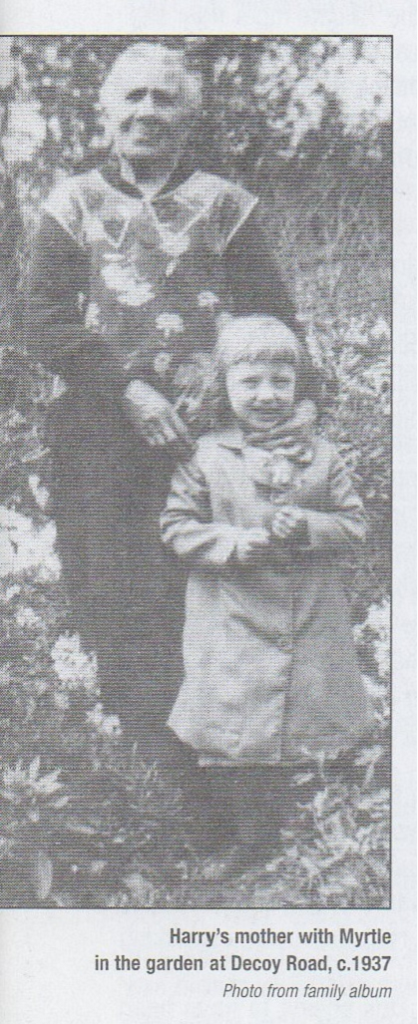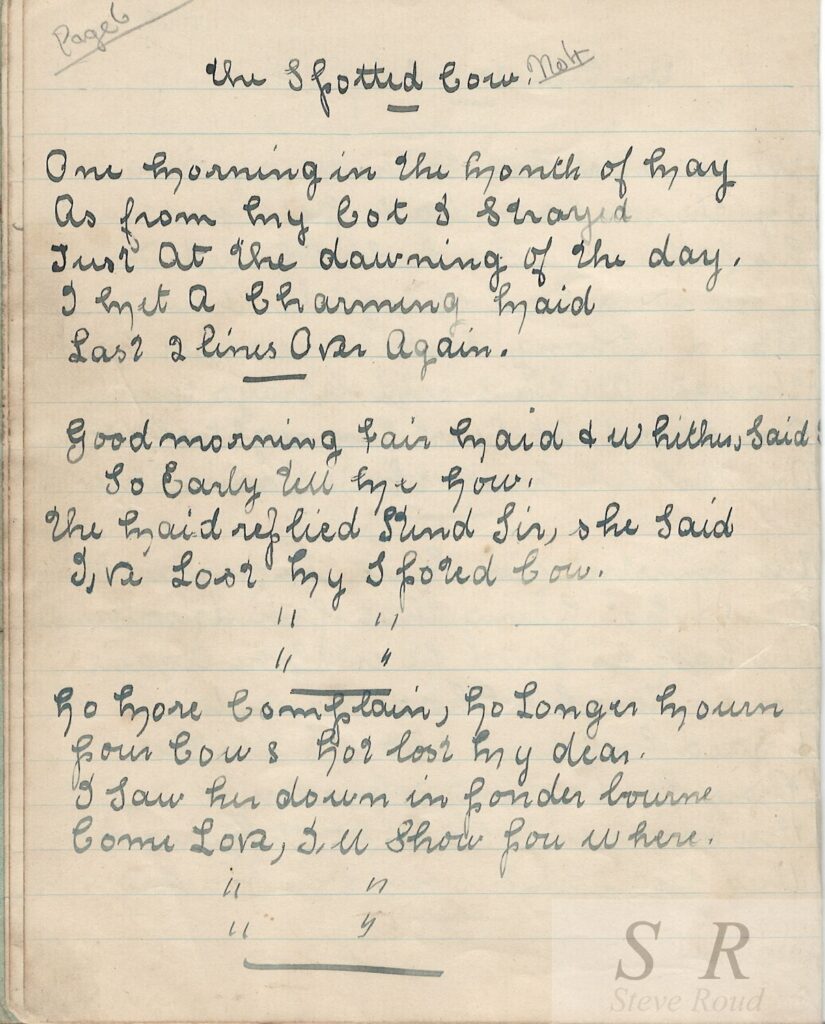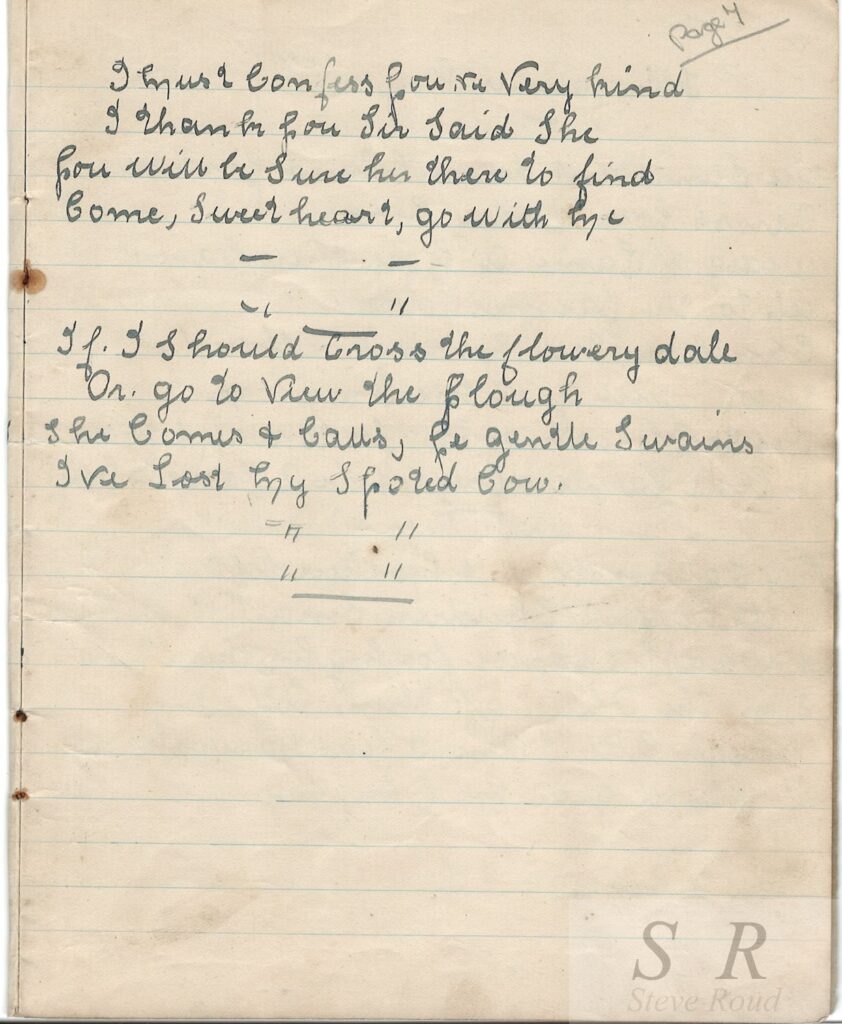Alan Helsdon writes about another member of the famous Norfolk Cox family – Laura, big sister to Harry.
The above copy is taken from Steve Roud’s Folk Song Index on the Vaughan Williams’ Memorial Library website. The original songbook is in the possession of Steve Roud.
The Family
Laura was the 5th child of Robert and Sarah Cox of Pennygate, Barton Turf, Norfolk, being born in 1880, 12 years after her parents’ marriage. Harry was born in 1885, was about 4 years younger than Laura, and the 7th child, to be followed by 2 more, including brother Fred (see Chris Holderness’ article for EATMT here). When I asked Chris Heppa, who has made a lifelong study of Harry and the other singers of East Norfolk (see CH B2-1-10) about Laura, he said he knew nothing, partly because her death was such a long time ago, and there are very few details of her sadly short life.
In the 1881 census she is aged 9 months and in the 1891 aged 10, living at home and attending school with her little brother Harry. By 1901 she was, as so often happened, in service, in a household at 35 Vicarage Road, Cromer, working for Emma Jarvis, widow of Ernest who had kept Tucker’s Hotel in the town. There were 5 children aged from 17 to 6 with a governess, and Emma would have been kept very busy as the only servant in the establishment. There is a family connection here, though exactly what is unclear. Agnes Salmons was born towards the end of 1865, about 14 years before Laura, but on the 1871 census Agnes is living with grandparents Jacob (55) and Susan Cox (60) in Barton Turf. Ten years later she has become Agnes Cox, living in Barton Turf still, but as ‘daughter’, aged 15, with Jacob Salmons Cox (39) and his wife Pamela (39). Another ten years later in 1891 she is Agnes Salmon (sic), a 25 year-old barmaid at Tucker’s Hotel, the establishment run by Ernest Jarvis. Ten years more and Laura Cox was housemaid to his widow. Harry Cox and John ‘Charger’ Salmons were good friends and frequently sang together, as noted by Chris Heppa who says they were both regular singers in Sutton Windmill and Catherine Wheel. (CH B2-1-12b).
Emma Jarvis died in 1909 and by the 1911 census Laura was a parlour maid at Gowthorpe Manor, Swardeston (4 miles south of Norwich) working for the Stewart family. At the age of 27 (this is her age stated on the census but her true age was 30), Laura now had one house maid (Constance Ellis, aged 20, from Bunwell) and a cook (20 year-old Mary Gould from Fritton) working with her and only two children running around, so life should have been a little easier. It was certainly more romantic as on the same census, in Swardeston itself was a Great Eastern Railway platelayer called John Ladbrooke and his family, including son Frederick, aged 17, a bricklayer’s labourer, carpenter and builder. Where Laura and Fred met we’ll never know, but meet they did, court they presumably did and get married they certainly did – in the first 3 months of 1914 in Norwich District, which includes Swardeston and Lakenham.
Laura of course had to leave on getting wed, and we have no direct evidence of where they lived, but the first of two sons, Frederick, was born in April – July 1914 in Henstead District which includes Swardeston, but not baptized as far as I can see. The second, George, was born in October – December 1915 and again not baptized immediately, but in an unusual entry in the Baptisms Register for St Mark, Lakenham, Norwich, dated September 5th 1920 we find the baptism of George Melville Ladbrooke, son of Frederick John (platelayer) and Laura Ladbrooke with ‘born 19.11.1915’ added in the margin (a fairly common entry by helpful clergy). What is not added, however, is that by September 1920 both young George’s parents were dead, In Kelly’s Directory of 1920, 29 Milton Street, Lakenham is the address for a Mr Ladbrooke. This street no longer exists but it was on the same line as the present (2021) Milton Close, off Southwell Road, Lakenham, a hundred yards from St Mark’s church.
Laura, at 35 years of age, had possibly gone home to mum for help with the birth of her first child, as happened a lot before formal midwives were available, although the birth is registered in Norwich District (which includes New Lakenham) not Smallburgh District (which includes both Catfield and Potter Heigham, in one of which the Cox family was then living), and she either stayed with mum for two years, or returned for some reason, because her death at 37 years is recorded in 1917 in Smallburgh District, (Harry’s later cottage Sunnyside is right on the border between the two parishes).
The next event was the death of her husband Frederick Ladbrooke, aged only 26 in Norwich early in 1920. At the moment there is no indication of the cause of death, but the so-called Spanish ‘Flu epidemic of 1918 did have a third wave in 1919, and ‘some historians suggest that there was a fourth wave in winter 1920, though it was far less virulent.’ www.britannica.com. Frederick may have been a victim.
Sadly son George Melville Ladbrooke did not last much longer. He may, as an orphan, have been living with a relative (grandfather or uncle) at 29 Milton Street as that name is in Kelly’s Directory for 1931 as householder, but his death is registered in 1934 in Erpingham District. As with his parents Laura and Frederick we do not know the cause of death but it is worth noting that the Sanitorium at Kelling, which treated TB patients at that time, is included in that District.
Laura and Frederick J Ladbrooke’s first son Frederick H Ladbrooke married in 1947 and produced a son and later descendants.
The Songbook
While in service in Cromer in 1905 the young Laura started to write the words of favourite songs in an exercise book. The list below shows they were largely popular songs with a limited number in common with the choice of her younger, more famous brother, Harry. Just like Harry though, she would surely have been influenced by their father Bob, who “could sing a different song every night of the herring fishing season” (Eastern Daily Press 1934; CH B2-1-6a).
When E J Moeran met Bob in 1921, four years after Laura died, Bob refused to sing because of ‘his own opinion of the decline in his singing ability. Moeran said that Bob saw himself as a maestro whose day was done. This was a great pity, as the very few people who remembered him in the area attest to his tremendous ability as a singer – they invariably rate him as a better singer than Harry himself’ (Chris Heppa, Harry Cox and Friends, CH B2-1-14a). Phil Heath-Coleman in his Mustrad article on Harry’s fiddling says, ‘Bob Cox was evidently a respected singer and fiddler, in much demand on festive occasions and in the local pubs’ (CH B2-1-31b).
Laura’s mother Sarah must surely have had an influence on the young girl’s love of song as well. In an interview with Michael Grosvenor Myer and Bob Thompson a few months before his death in 1971, Harry said, ‘My mother, she used to go to Norwich way over; she was young then, and she had tunes what I learnt. I never see the sheets; my mother learnt them and I learnt them off her. . . . I wasn’t born when she used to get them sheets. She used to go to Norwich a good bit in them days. Her father, he had no pona and cart, and no donka and cart; but he used to do a bit of digging round about the parish, taters, spuds. And he used to supply them shops in Norwich. She used to go on her old donka – but that was a darn sight slower than walking. She was only a girl. I suppose she went more then than she ever did after. She never had the damn time to go no more.’ (CH2-1-1a)
What Harry says here is almost unbelievable really. His mother Sarah probably before her marriage in 1868 at the age of 18 (’19’ in the register), or before the birth of her first child Sophia in 1871, used to walk the 13 miles from Pennygate, Barton Turf to Norwich on a Saturday, with a slow donkey carrying vegetables. She would then either take them to shops or possibly stand on the market until they all went (only able to sit when one of the baskets was emptied), buy a song sheet (for ½d or 1d – Harry’s interviews vary) and then walk, or possibly ride, the 13 miles home again. That’s at least 5 hours travelling each way and possibly a couple of hours in Norwich. making at least a 12 hour day. Not so bad in summer but potentially a horrible trip in winter with dark at the start and finish. At least, in summertime while the light held she had the chance to learn a new song on the way home. This photograph of Sarah with her grand-daughter Myrtle, taken in 1937 shows a tall, strong-looking woman. She died in 1944, aged 93.

Laura’s mother Sarah Cox and niece Myrtle, Harry’s daughter, about 20 years after Laura died.
Like Harry, Laura made for herself a song book and though she never became famous like her ‘little brother’, who was 32 when she died aged 37 in 1917, the book must have been dear to her, especially in her attic room after a long and exhausting day’s work. She was just an ordinary maid in service with an ordinary choice of songs, but what a treasure it is to have her book and to be able to see her favourite songs in her own handwriting.
CH references above are to Chris Holderness’ Archive at EATMT. For access to individual articles within this archive, please contact EATMT via email: info@eatmt.org.uk.
The Songs
To access the pages of Laura’s songbook below, go to vwml.org, enter ‘laura cox songbook’ in the (‘All Fields’) ‘Advanced search’ box (top right), and click ‘Submit’ (mid right). Click on the first page of ‘Farmer’s Boy’ and use the arrows to view them all.
1 Barbara Allen Roud 54 BB* 187b
Samuel Pepys refers to this song in 1666, and Steve Roud and Julia Bishop suggests it was written for an earlier stage performance. Sung by brother Harry.
2 The Ash Grove Roud 24988
The first version of the English words appeared in 1862 in Welsh Melodies, with Welsh and English Poetry, compiled by John Thomas. Frank Kidson claimed that the tune derives from the Morris tune Constant Billy.
3 The Minstrel Boy Roud 13867
Words written by Thomas Moore, as was no 10 below, and set to the melody of The Moreen. The song became popular amongst Irishmen fighting in the American Civil War.
4 The Spotted Cow Roud 956
From A L Lloyd in the sleeve notes to Peter Bellamy’s The Fox Jumps over the Parsdon’s Gate: ‘written for the London pleasure gardens, appearing on a Vauxhall Gardens song sheet in the 1740s.’ It was sung by brother Harry.
5 The Farmer’s Boy Roud 408 BB* 33b
First found in an 1832 catalogue of street ballads from James Catnach, a well-known London printer, but thought to be older.
6 The Old Folks at Home Roud 13880
By Stephen Foster in 1851. Also known as Swanee River.
7 Early One Morning Roud 12682
Words from late C18 and melody first printed in William Chappell in English Airs, of 1855- 59.
8 The Mermaid Roud 124
From around the mid 18th century, and very common. Also known as The Stormy Winds do Blow.
9 The Bailiff’s Daughter Roud 483
The earliest known text was published (as a broadside) by Phillip Brooksby between 1683 and 1696. The tune dates from 1731 (ballad opera The Jovial Crew).
10 The Last Rose of Summer Roud 13861 BB* 229c
A poem by the Irish poet Thomas Moore, as was no 3 above. He wrote it in 1805 . . . published in December 1813 in Volume 5 of Thomes Moore’s A Selection of Irish Melodies.
10a Loch Lomond Roud 9598
First published in 1841 in Vocal Melodies of Scotland. Historian G H Pittock writes that the song is a Jacobite adaptation of an eighteenth century erotic song, with the lover dying for his king, and taking only the ‘low road’ of death back to Scotland. Added later, filling a space on the page.
11 Blue Bell Roud 11331
Edward Madden (lyrics) and Theodore F Morse (music), copyright 1904 by F B Haviland Publishing Co Inc, New York. Laura’s middle verse is not included in the sheet music.
Notes about songs mainly from Wikipedia.
* BB = The Bolingbroke Collection of Ballads and Songs, Norwich Heritage Library,
C 821.040S (BBS)

